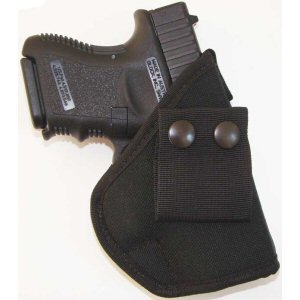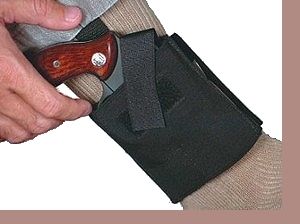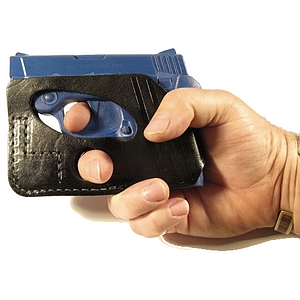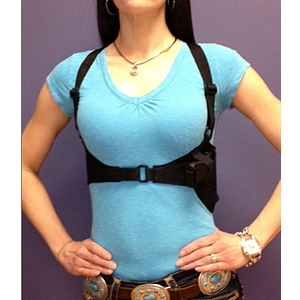An often overlooked part of handgun selection is the holster. When openly carrying a handgun, fewer issues need to be considered during selection because you do not have to worry about concealing your weapon and a bulky generic holster can often suffice. However, when selecting a handgun for concealed carry, discussing the holster at the same time can be very helpful. Issues such as method of carry, weapon type, body type, and activities performed while carrying need to be considered to make sure the desired weapon can be carried as expected. This will allow one to get the ‘best’ concealed carry holster.
The most important issue regarding a concealed carry holster is method of carry. Some of the most popular ways of carrying include: Inside the Pant (ITP) or Inside the Waistband (IWB), Belt Holsters or Outside the Waistband (OWB), ankle holsters, pocket holsters, and shoulder holsters. Other carry methods such as belly bands, jogging holsters, concealed carry purses, and other alternative methods will be discussed in future articles.
Waistband Holsters – Inside or ITP and Outside or Belt Holsters, are very common for concealed carry. They are worn on the waistband and usually clipped to the pants and belt. Holster styles are available that allow a person to place the holster anywhere on the waistband (360 degrees around) depending on a number of factors. IWB holsters include a variety of options and styles. Some allow you to tuck your shirt in while still concealing the weapon. These holsters can have different clip styles including J-Hook, metal clips, snaps etc. Some of these holsters can be ambidextrous. These variations make these holsters very versatile for many clothing styles. IWB holsters, and to a lesser degree OWB holsters, may be uncomfortable depending on body type and the level of activity (bending, sitting etc). So choosing the right holster for you is important. IWB holsters generally use the belt and pant tightness to retain the weapon in the holster although some styles do have retention straps.
Ankle Holsters are usually found to be comfortable and aren’t as susceptible to ‘printing’ (showing the outline of the gun through clothing). This holster is best limited to smaller handguns. The main requirement is that you need to be able to quickly reach your ankle. An ankle holster can also be a great spot for a back up weapon. In situations where other types of carry simply won’t work (weapon printing etc), the ankle holster can be a good option.
Pocket Holsters
are easy to use and are fairly comfortable. They can be susceptible to printing depending on the style but a good pocket holster should provide great concealment. Nothing else should be carried in that pocket. The exterior of the pocket holster is usually textured to prevent it from coming out of the pocket while drawing the handgun. Pocket holsters usually have lower retention than waistband or ankle holsters.
are easy to use and are fairly comfortable. They can be susceptible to printing depending on the style but a good pocket holster should provide great concealment. Nothing else should be carried in that pocket. The exterior of the pocket holster is usually textured to prevent it from coming out of the pocket while drawing the handgun. Pocket holsters usually have lower retention than waistband or ankle holsters.
However a Wallet Holster can be an option. It prevents printing, protects the weapon, and adds a little ‘meat’ to hold on to those too small 380s since the weapon stays in the holster during firing.
Shoulder Holsters are carried with a harness system around the shoulders and require a cross draw – weapon carried on the left side if you are right handed and vice versa. The weapon will sit butt forward, between the bicep and the rib cage. These holsters can usually conceal a large frame handgun depending on the size of the wearer and clothing chosen. This carry method will generally require an over shirt or jacket to conceal the holster and harness. Some shoulder holsters are designed specifically for women For many it is the most accessible system to carry and can provide a very fast draw depending on your clothing.
Handgun size is another factor in holster selection. The larger the handgun, the harder it will be to conceal and probably the less comfortable it will be. However, a weapon that is too small may not provide sufficient stopping power in an altercation. Minimum requirements of a conceal handgun are outside the scope of this article but caliber, number of rounds, etc. will affect handgun size. The larger calibers will generally be larger in size but not always. Revolvers are generally larger (at least wider) than semi-automatic handguns. Larger weapons will generally be carried in a shoulder holster, OWB, and maybe some IWB. Smaller weapons usually allow for a wider variety of carry styles.
Body type and activities to be performed while carrying need to be considered when choosing a holster. Highly active people will need to make sure the holster provides the required retention and is not in a location that will get in the way or print or be exposed – reaching up, bending over etc. A large framed person will be more likely to conceal a large framed handgun without the weight/size bothering them. A small framed person may be more flexible and able to carry in a larger number of positions.
Method of carry, weapon type, body type and activities to be performed all need to be considered when deciding on a handgun and a conceal carry holster. There is no one holster that is the best concealed handgun holster. There is only the ‘best’ for each individual.







没有评论:
发表评论